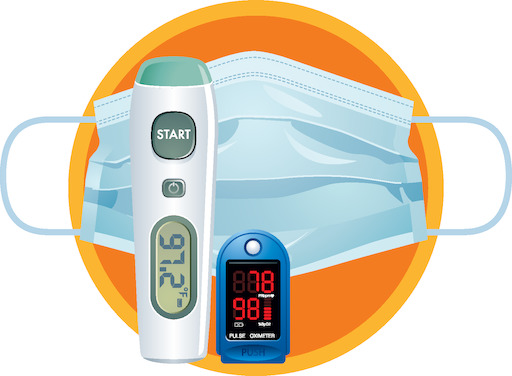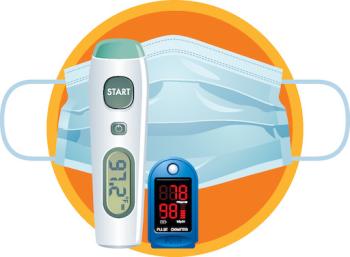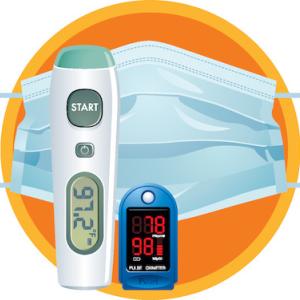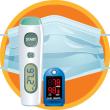Is it flu, COVID-19, or a cold?
You wake up one morning and just feel off. Your throat is a bit scratchy, you are feeling stuffed up, you have got post-nasal drip, feel warmer than usual and your body feels like it has been hit by a small truck. Before COVID-19, you would have said, “Eh, it’s just a cold, maybe the flu.”
But now, deep in a second wave of COVID-19, you will worry if you have contracted this new illness. How can you tell the difference? Can you tell without a test?
The Center for Disease Control and Prevention says COVID-19 symptoms can take longer to show up after exposure than the flu. So COVID-19 is easier to pass on to others. Typically, patients have been developing symptoms of COVID-19 five days after being infected, but symptoms have shown up two days or 14 days after infection.
People can spread the virus for about two days before experiencing signs and remain contagious at least 10 days after signs or symptoms first appeared. If someone is asymptomatic or their symptoms go away, it is possible to remain contagious for at least 10 days after testing positive.
There are shared symptoms between COVID-19 and the seasonal flu: fever or feeling feverish/chills, cough, shortness of breath or difficulty breathing, feeling tired, sore throat, runny or stuffy nose, muscle and body aches, and head pain.
One big symptom of COVID-19, but not the flu, is the loss our senses of smell and taste. The cough associated with COVID is usually dry. According to the CDC, both illnesses can include sore throat, congestion, nausea or vomiting, and diarrhea. Serious COVID-19 symptoms are difficulty breathing or shortness of breath, chest pain or pressure, and loss of speech or movement.
The World Health Organization also lists conjunctivitis, headache, loss of taste or smell, a rash on skin, or discoloration of fingers or toes. The list of COVID-19 symptoms grows as more cases are confirmed.
Bottom line: If you are feeling sick, and are experiencing symptoms of either illness, stay home and call your doctor.
“We have the ability to test for both (using the same swab; no need for two swabs) when needed,” said Cheryl Liechty, MD, PPH, head COVID-19 director of resources for Waldo and Pen Bay hospitals. “Not everyone needs a flu test. Generally, we prioritize flu testing in people for whom influenza antiviral medications are indicated based on national treatment guidelines.
“Generally, these are people who are at higher risk for complications of influenza (similar to high risk for COVID-19 complications) or who are already sick enough to require admission to the hospital. That means we will end up doing lots of COVID-19 testing, but more targeted influenza testing,” Liechty said.
The U.S. Department of Health and Human Services announced Oct. 2, the Public Health Emergency (PHE) declaration for COVID-19 was renewed for another 90 days, beginning Oct. 23, when the PHE was previously scheduled to expire, and extending through Jan. 20.
Check with your insurance company about coverage. At America’s Health Insurance Plans (AHIP) at https://www.ahip.org/health-insurance-providers-respond-to-coronavirus-covid-19, here is what some insurance companies in Maine are covering.
Harvard Pilgrim Health Plan has waived all cost-sharing payments for COVID-19 treatment provided by in-network providers through Dec. 31, 2020. The waiver applies to all Harvard Pilgrim fully insured commercial, Medicare Advantage and Medicare Supplement members.
Blue Cross Blue Shield /Anthem is waiving cost-sharing for the treatment of COVID-19 through Dec. 31, 2020 for members of its fully insured employer, individual, Medicare Advantage and Medicaid plans. Cost-sharing for COVID-19 diagnostic tests as deemed medically necessary by a health care clinician who has made an assessment of a patient, including serology or antibody tests, for members of Blue Cross Blue Shield /Anthem’s employer-sponsored, individual, Medicare and Medicaid plans. Cost share waiver extends to the end of the public health emergency. (https://providernews.anthem.com/maine/article/information-from-anthem-for-care-providers-about-covid-19-updated-march-19-2020-1)
United Healthcare: $0 cost share (co-pay, coinsurance or deductible) for COVID-19 testing-related visits during the national public health emergency period, scheduled to end Jan. 20 for in-person or telehealth visits.
As for the common cold symptoms – sneezing, stuffy or runny nose, sore throat, coughing, watery eyes, these usually peak in about three days, but symptoms can remain for up to 14 days.
Please note: We encourage everyone to consult their primary care professional on best courses of action for your individual health and how they may interact with any ongoing treatments.
Event Date
Address
United States


























